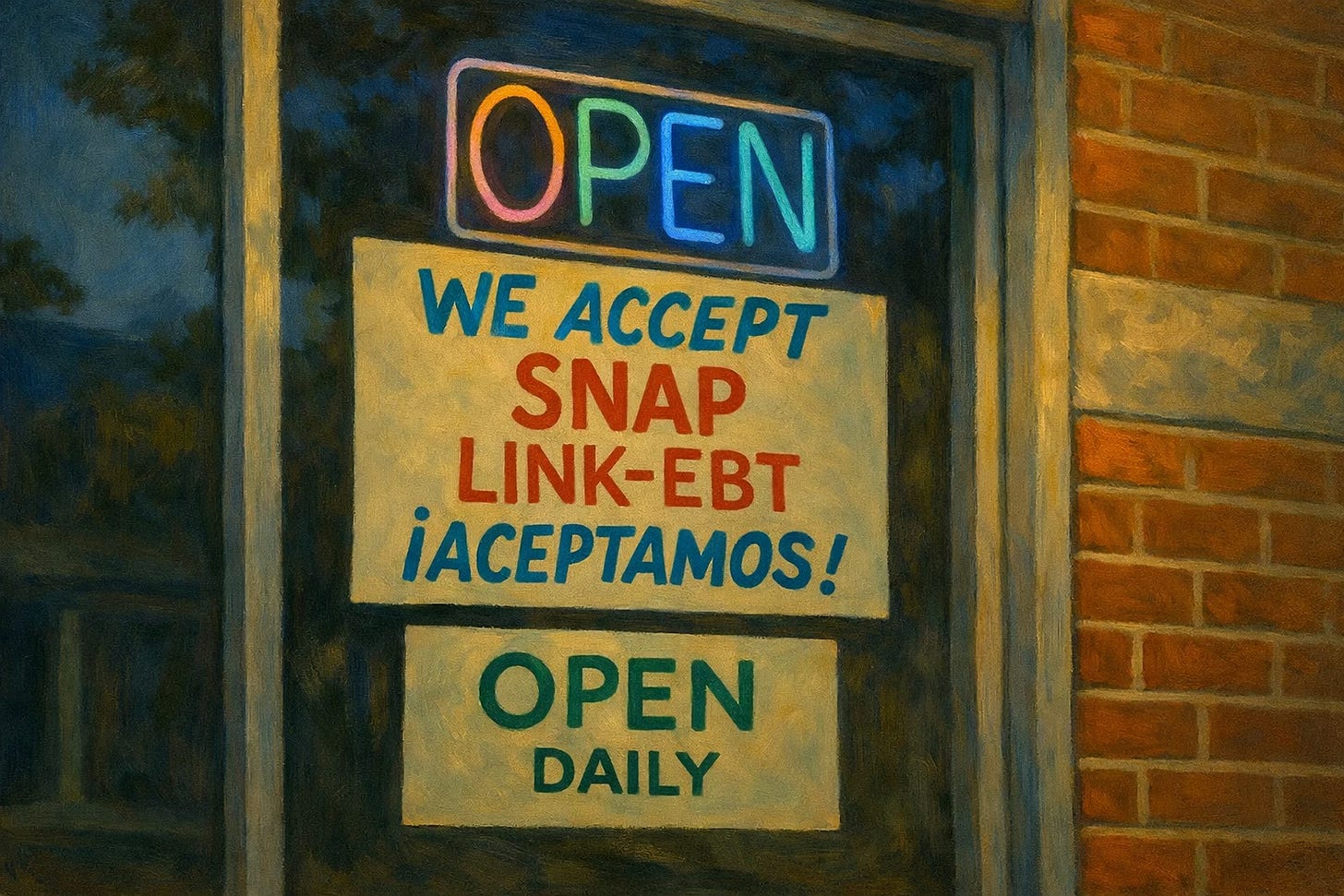SNAP vs. Shutdown Politics
Millions of Americans went without food while $23 billion in SNAP reserves sat unused.
The Trump administration let 42 million Americans go hungry for a month. Then pretended it had no choice.
It had $23 billion sitting in reserve.
A federal judge called the bluff.
October 1, 2025. Government shutdown. Standard chaos, except this time the USDA announced it would suspend SNAP benefits starting November 1st.
Sixteen million children about to miss meals. Forty-two million people with a median EBT balance of $5.43. Over 30 percent had less than a dollar left.
The agency’s reasoning? No appropriations, no money, sorry folks.
Except that’s not how it worked in 2019. During the last shutdown, USDA guidance explicitly stated the agency could tap its multi-year Contingency Fund to keep benefits flowing during a lapse. Standard procedure. Humanitarian baseline.
Six years later, same fund, different story. The administration suddenly claimed the Contingency Fund was only for natural disasters. Not shutdowns. Not appropriations gaps. Definitely not for feeding people during a manufactured political crisis.
That reversal, with no change in the law, is the tell.
Two dozen states sued. California, New York, Pennsylvania, Massachusetts. The coalition argued the USDA was violating the Administrative Procedure Act by refusing to use legally available funds.
Initial court orders came fast. Judge Indira Talwani in Massachusetts and Judge John J. McConnell in Rhode Island both ruled: use the Contingency Fund. Now.
So the administration did. Sort of.
USDA Deputy Under Secretary Patrick Penn announced the agency would drain the entire $4.65 billion Contingency Fund. Problem: that only covered 50 to 65 percent of November’s obligation.
Partial payments to everyone. Not full payments to some. Maximum visibility. Maximum pain. Penn’s team warned states it would take weeks to reconfigure EBT systems for prorated benefits. IT staff scrambling. Payment errors inevitable. Delays guaranteed.
Administrative sabotage by compliance.
They followed the letter of the court order while ensuring the gap was loud, national, and televised.
But here’s the part that matters.
The USDA had another pot of money. A much bigger one. Section 32 funds: $23 billion, accumulated from customs duties, legally available for agricultural and nutrition programs. Including SNAP.
The administration refused to touch it.
Penn’s brief stated the agency was reserving Section 32 for other child nutrition programs. Future needs. Other priorities. Not the immediate crisis. Not the 42 million people who’d been without full benefits for weeks.
On paper, that sounds prudent. Resource management. Fiduciary responsibility.
In practice? Judge McConnell saw through it.
The administration’s argument relied on two premises: legal ambiguity and executive discretion. First, the claim that Section 32 funds could be used for SNAP but didn’t have to be. Technically true. The law gave USDA discretion.
Second, the framing that withholding those funds was rational prioritization. Saving money for programs that might also face shortfalls later.
Both collapse under scrutiny.
McConnell ruled the decision arbitrary and capricious under the APA. Not just wrong. Unlawful.
Here’s why: SNAP exists to prevent hunger. That’s the statutory purpose. The administration had the means, the authority, and the need. Choosing to reserve funds for hypothetical future shortfalls while people went hungry right now wasn’t rational resource allocation.
It was policy via starvation.
McConnell didn’t mince words. He accused the Trump administration of withholding benefits for political reasons. The evidence? A presidential statement saying food stamp funds would only be released when the Radical Left Democrats open up government, and not before.
The court ordered full funding by Friday. No pause. No delay. McConnell’s exact words: People have gone without for too long. Delaying payments for even another day is simply unacceptable.
(Find the money, or face contempt…)
The administration folded. Announced it wouldn’t appeal. Section 32 funds quietly moved into SNAP accounts. Forty-eight hours after fighting to avoid using that money, it suddenly became available.
The precedent matters more than the outcome.
McConnell’s ruling established that executive discretion over entitlement funding has limits. Can’t invoke prioritization to justify mass suffering when the legal authority and financial means exist to prevent it. Especially when prior guidance proves the agency knows exactly how to handle this.
That’s the throughline: inconsistent interpretation as a weapon. The USDA changed its reading of the Contingency Fund not because the law changed, but because the politics did.
The goal wasn’t fiscal responsibility. It was leverage. Maximize the crisis. Maximize the pressure. Force Democrats to fold by making 42 million people collateral.
It almost worked.
What stopped it wasn’t public outcry or congressional action. It was a federal judge in Rhode Island who looked at $23 billion in discretionary funds, 16 million hungry kids, and an administration claiming its hands were tied.
And said: prove it.
They couldn’t.
States are still dealing with the administrative chaos. Virginia declared a state of emergency and used its own funds to plug the gap. Texas debated whether to raid reserves. Multiple states scrambled to reconfigure EBT systems three separate times in less than a month. Zero funding, partial funding, full funding.
The damage wasn’t just delayed benefits. It was shattered trust in the system’s reliability. And for what? A shutdown that ended anyway. A funding fight that solved nothing.



I grew up in Aspen during the 70s-80s. The influential parents of my time there ranged from John Denver to Hunter S. Thompson. Trying to find ways to inspire influencers of today by some of the originals…before the computer.
So, I have created this series of articles. I am calling it…”Voices of the past talking about the present, trying to inspire a better future” … be it Positive or Gonzo. https://open.substack.com/pub/growingupaspen/p/corporate-welfare-vs-snap-reality?r=2g93c&utm_campaign=post&utm_medium=web&showWelcomeOnShare=false
I think he’s resisting giving the money out. I don’t have any proof but it’s just a gut feeling. I don’t think the money is there. Can you say corruption?